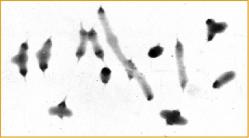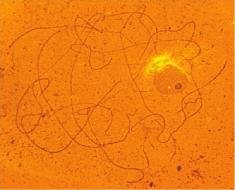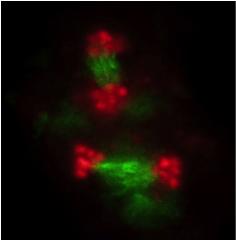Research
| In the last thirty years I have mainly been interested in the study of the meiotic process especially from a cytogenetic point of view. Meiosis underpins sexual reproduction in both plants and animals where it is essential for ensuring the stability of the chromosome complement from generation to generation. It is characterized by the presence of a single round of DNA replication followed by two successive rounds of chromosome segregation. In order to ensure an accurate chromosomal segregation, homologous chromosomes must rearrange into bivalents. After the recognition of homology (pairing), the synaptonemal complex is assembled along them (synapsis), and they exchange reciprocal chromosomal regions (recombination). The proper biorientation of bivalents at the metaphase I plate, and therefore the segregation of a complete set of recombined chromosomes at anaphase I, is ensured by the existence of at least one chiasma (the cytological visualization of a crossover event), in combination with the existence of sister chromatid cohesion. During the second meiotic division sister chromatids separate, allowing the formation of haploid gametes, which after fertilization restore the diploid chromosome number of the species. An understanding of this process is critical to further research on reproduction, fertility, genetic and breeding. |
|
|
In the first period (1980-1993), our interest was -The study of natural polymorphisms for supernumerary heterochromatic segments and B-chromosomes in grasshoppers. -The use of C-bands as cytological markers to analyze the meiotic chromosome behaviour in situations involving structural and numerical alterations. - The comparisons of chiasma frequencies and distributions in males and females of several species of grasshoppers. -The phenomenon of somatic nucleolar competition between chromosomes of different species of cereals. |
 |
|
In a second period (1993-2001) we carried out: -Development of cytological methodologies that have allowed the visualization of synaptonemal complexes (SCs), under ligth and electron microscopy. -Analysis of the processes of pairing and synapsis (SC formation) of homologous chromosomes at prophase I in wild type individuals of different plant and animal species. -Extension of these type of analyses to gene and chromosomal mutants to get information on the mode of action of meiotic genes and on the role that chromosome structure and chromosome number play in homologous pairing and synapsis. |
 |
|
From 2002 to date we are developing a project aimed to the identification and characterization of genes and proteins involved in meiosis, especially in homologous recombination, in Arabidopsis thaliana (an important flowering plant model species) by using a combination of molecular cytogenetics and molecular cell biology. This includes an EC funded collaborative research project in which we are using a systems biology approach to define the protein networks that control meiotic recombination in Arabidopsis. -In addition, we continue performing an active research in insect meiosis (relationship between synapsis and recombination, chromosome structure, cohesin dynamics etc.) in collaboration with Dr. Julio Rufasgroup (Universidad Autónoma de Madrid, Spain). |
 |
